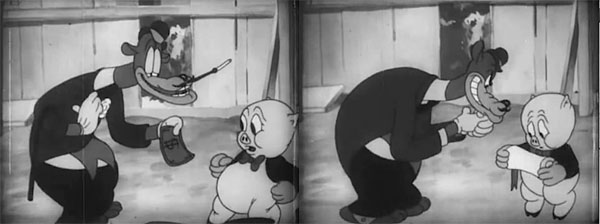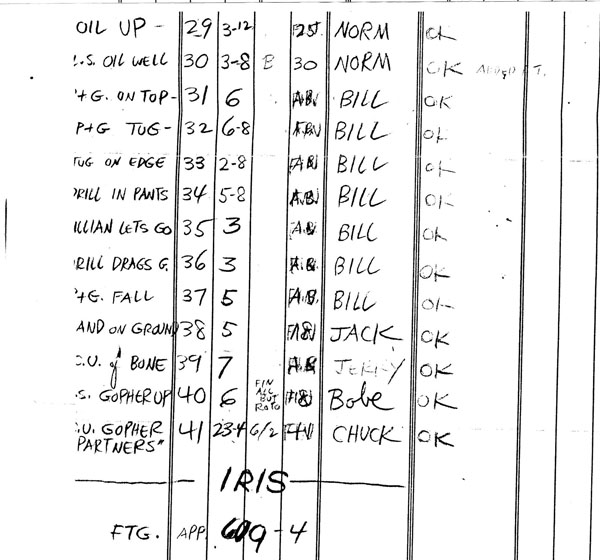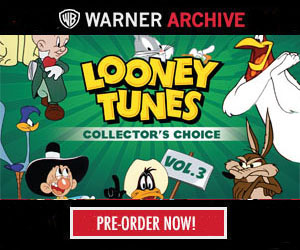
I’m as intrigued as you all are — an animation breakdown for a 1937 B&W Porky Pig cartoon?
Bob Clampett’s second cartoon, Get Rich Quick Porky – tentatively titled The Oily Bird Gets Porky — was his first at the Schlesinger studio without Ub Iwerks’ input (Iwerks laid out Clampett’s first directorial credit, Porky’s Badtime Story, before he left.) Looking at the draft, May 10th is the earliest date animation was known to begin, with a finish date as late as June 2nd, whereas the cartoon was released August 28th. Clampett’s promotion to director was announced in The Hollywood Reporter on May 20th. A month later, his unit moved back on the Warner lot, making this the last cartoon Clampett produced at the Iwerks Studio.
This entry is not subject to sheer bedlam, as would be Clampett’s trademark, but it is still part of the “home run” period that seemed to dwindle after Porky in Egypt. Avid cartoon fans might have watched this in countless PD home video compilations, albeit the Korean re-colored version. Besides Mel Blanc as Porky and storyman Cal Howard as the short-lived Gabby Goat, actor Earle Hodgins provides the voice (resembling radio actor Eddie Marr) for the oil huckster, Honest John. He had previously voiced the pill salesman in Porky the Rainmaker and the opening narrator in The Village Smithy, both Tex Avery Porky Pigs released a year earlier.
Besides established animators Chuck Jones, Norm McCabe, John Carey (credited as “Jack”) and Bobe Cannon, a large amount of footage belong to both Jerry Hathcock and Bill Hammer, two uncredited animators brought over from the Iwerks studio. It’s fascinating to see some of Cannon’s early animation, not bearing the earmarks of the “silly putty” quality that would later emerge in Jones’ own cartoons. John Carey’s scenes have a nice solidity in their drawing, with animation that uses smooth and even inbetweens (notice the movement of Porky and Gabby’s decision to sign the deed).
Besides being in charge of the character layouts in Clampett’s early cartoons, Jones’ draftsmanship in his work is clearly evident in his scenes, which includes the longest sequence (at around 99 feet). The posing and animation of the nonchalant magician gopher are just as graceful as the disappearing act he performs with a Pluto-esque hound’s bone. It’s also held together with a slight inkling of the gopher’s blasé demeanor that would later be inherited to Bugs Bunny.

There is an intriguing animator switch in the film where in scene 25B (animated by Hathcock, above left), Honest John exchanges a lone dollar bill to Porky for the deed. It switches to Norm McCabe’s animation (above right) when the camera pans down below where Gabby drills deep into the ground with the jackhammer. McCabe handles the continuation of the shot — panning back up — with Honest John, wringing his greedy hands. Note how different the drawing styles are. The clean-up in Hathcock’s work is fairly iffy while McCabe’s shows more consistency.
Once again, I’ve embedded an “animator breakdown” video, with the actual draft shown below. (I’m afraid the identity of “Gordon” is unknown at the time of this posting. “Tom” could be Iwerks’ staff animator Tom Massey.) Enjoy this video so saturated with oil that you could literally wring it out with your fingers!


Special Thanks for help on this post: Mark Kausler, Jerry Beck, Mike Kazaleh, Mike Barrier and Joe Campana.


 DEVON BAXTER is a film restoration artist, video editor, and animation researcher/writer currently residing in Pennsylvania. He also hosts a
DEVON BAXTER is a film restoration artist, video editor, and animation researcher/writer currently residing in Pennsylvania. He also hosts a 



















































































Remember this primarily because it had a man get a jackhammer down his pants accompanied by screams. That and the gopher.
Naturally got a kick out of the description “Drill in Pants”…was it suppose to be a drill early on? Or was it just easier to call it a drill on the sheet?
Also this is one of possibly the only one in which Gabby didn’t dominate much of the action nor showed the usual traits of being a Donald Duck clone.
Gabby sounds kind of like the Other Gabby when he’s on the drill/jackhammer. Although that other Gabby didn’t exist yet. 🙂
I love the fact that they’ve used an exposure sheet to write this thing up on.
All the Warners drafts seem to have been written like this. Notice that in the new headings at the top of the sheet, Clampett is described as “writer/director”. Seems he was already trying to make it clear his creative input went beyond being a mere “supervisor”… if only to the people at the studio!
Thanks to the miracle of Myopi-vision, I now want to see a 1930s Clampett cartoon called Porky The Re-Animator.
Utterly fascinating!
I wonder if an animator had to stay at the studio for X amount of time before he got into the rotating credit pool? Hathcock and Hammer are fine animators, but perhaps their stays at Schlesinger were short-lived…?
I think that Chuck Jones helped out Bill Hammer on Scs. 20 and 20A, some of the poses look like Chuck’s drawing, and the timing of the dog suspended in the air by the four little oil gushes really has that Jones look (he did the character layout for the cartoon after all).
I love the little touches that Chuck put in to sc. 22, especially that little flickering eyelid on the dog (on ones), in fearful anticipation of what the gopher will do next. Chuck liked to put down his animation of the 1930s, especially his work for Clampett, but I think it shows real talent. Chuck was a great animator!
You can really see the Iwerks style in Bill Hammer’s animation of Porky and Gabby trying to get traction on the oil gusher in 35, 36 and 37. There’s a lot of obvious dry brush on the legs and follow throughs on the arms that stand out as Iwerks hallmarks. You can see a lot of these in cartoons like “Porky’s Super Service”, which was also done at Iwerks. There are Bill Hammer artifacts in cartoons like Iwerks’s Columbia release, “The Horse On The Merry-Go-Round”. Good to see this all set down in sequence, Devon, makes you think!
Final hurrah for Gabby Goat, was it not?
Indeed it was, Bob.
A very nice post, Devon. Thanks to valuable surviving documents and today’s technology we can approach cartoon history in an ideal way. I love Stalling’s musical puns at the start with the sign…the music segues from When My Dreamboat Comes Home to With Plenty of Money and You. Also I think Billy Bletcher does a line at the start as the driver (suspect he did this line for this cartoon while recording a different role on another, a very common thing). Hodgins did this con-man voice in films and on radio at the Warner station KFWB. The gopher at the end sounds like an in-house voice but I can’t say for sure. Again, well done.
KEITH:Also I think Billy Bletcher does a line at the start as the driver (suspect he did this line for this cartoon while recording a different role on another, a very common thing).”
He does… agreed a very fine thing..gopher seems like an in-house voice like you said. Besides Blanc as Porky and Hodgins as the weasel, Blanc as the dog and Cal Howard as “final-appearing” Gabby.
Interesting how Chuck Jones is the only credited animator when he only did two scenes. According to the draft he did the character layouts, so that’s probably who gets screen credit during this time.
This was one of five cartoons where Chuck Jones got sole animator credit for Bob Clampett, although historians have debated exactly what Chuck’s role was. On Clampett’s next six cartoons there were two animators credited, but while the second position “rotated” between the other animators in the unit, Chuck was always one of the two credited, suggesting that he still had a higher position than the others, even if it wasn’t as high as it was when he got solo credit. Then Frank Tashlin left the studio, Chuck was made director in his place, and the rest is history!
Although Chuck only animates two scenes on this cartoon, notice that he was given sole responsibility for the gopher.
When Jones said he and Clampett were to be ‘co-directors’ you can kind of see it in this cartoon, which is almost two separate stories that only come together at the end. Jones and Bill Hammer’s work is pretty much a try-out for Chuck’s series of “Two Curious Dogs” cartoons that would debut right after he took over Tashlin’s unit, while the other animators under Clampett focus on what are supposed to be the main characters, and fall far more under Bob’s sensibilities (you almost wonder why he didn’t bring the jackhammer-in-the-pants gag back around in the 1940s, when his unit and the studio’s level of draftsmanship was far more advanced).
Thanks for posting these things, Devon — I think they’re terrific. For what it’s worth: there was some speculation earlier about what happened to Jerry Hathcock. I have him being hired at the Disney studio in February 1940. I don’t know how long he stayed there, but throughout the 1940s, at least, he seems to have worked exclusively as an effects animator.
One of those cartoons I used to see a lot as a kid. Thanks for the breakdown again, Devon!
That mysterious “Gordon”, do you suppose that he’s an assistant animator that was given a chance to animate in this short? Seeing that he only did one scene.
The only Gordon I can think of is George Gordon, but he was at MGM at the time this was made.
What a terrific fun cartoon — never seen this one before so it’s a real treat!
“Tom”‘s only credits are sharing scenes with Norm McCabe. Was he maybe McCabe’s assistant?